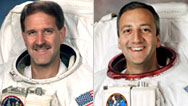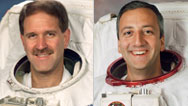Life of an Astronaut
- By Melissa Salpietra
- Posted 07.01.08
- NOVA scienceNOW
In this video, veteran spacewalker Mike Massimino discusses the extreme rigor, both physical and mental, that's required of astronauts who are training for a spacewalk. Every aspect of every EVA, or Extra-Vehicular Activity, is painstakingly rehearsed, many in a giant pool called the Neutral Buoyancy Lab, which simulates weightlessness.
Transcript
Life of an Astronaut
Posted: July 1, 2008
ARCHIVAL RECORDING: Home to Earth comes the voyager. Cheers the thrilled lines of proud Americans. In ceremonies at Mercury Control Center President John F. Kennedy presents the NASA Distinguished Service Medal to astronaut John Glenn.
NARRATOR: All the glory and glamour aside, what is it really like being an astronaut?
MIKE MASSIMINO (NASA Astronaut): It is pretty physically and mentally draining. This is quite an experience that you're going through.
NARRATOR: For the past year and a half Mike Massimino has been training for the upcoming Hubble Repair Mission as a lead space walker. And Massimino can tell you that being an astronaut isn't all zero gravity and freeze-dried ice cream.
MIKE MASSIMINO: The physical part is you're in the space suit, And you're in this suit for about eight hours from the time they put you in to the time you get out. There's no food in there with you so you have to have a good breakfast, you do have a drink bag so you can drink water while you're doing this but you really need to be in the best shape you can be in. It's also mentally fatiguing because you have to think about what you're doing, if you do an "oops" you get in trouble. You have to really concentrate on what's going on. You can't think about what you're going to have for dinner that night, although you might like to, but you really got to think about what you're doing. It kind of gets to you and those last couple hours you could get fatigued and start making a mistake you really wouldn't want to make.
NARRATOR: Massimino and his team will be doing everything from replacing batteries and insulation to intricate repair work on one of Hubble's main cameras. Every space mission is dangerous, and even if the astronauts remain safe, one small mistake could compromise the world's most famous telescope. So training is paramount. But training astronauts here on Earth for a mission in space is a challenge in itself. NASA relies heavily on the Neutral Buoyancy Lab.
MIKE MASSIMINO: The Neutral Buoyancy Lab is a fancy name for a big giant pool. We can fit a whole space shuttle in there plus a whole space station, it's huge. They try to get us neutrally buoyant. That enables us to practice our space walking. We can egress the space shuttle and move along the handrails and work with the telescope and it's very close to learning the body positioning and the skills you need to space walk.
NARRATOR: An astronaut is only part of the picture. Behind every NASA mission, there is a vast team of experts who play a huge role in the preparation of the flight team.
CHRISTY HANSEN (Astronaut Trainer): We're their coaches, their teachers, their Flight Controllers, and their friends. We write all of the procedures for their space walks; which crewman is going to do what, who is better in this area vs. that, who is going to be on the arm. And we make that into one continuous procedure that we just update constantly. And the choreography is just down to the dime so that we don't waste any time.
NARRATOR: Each EVA, or Extra Vehicular Activity, that an astronaut is scheduled to perform in space is painstakingly practiced here on Earth, dozens of times over a course of years. All in an effort to work out the kinks.
MIKE MASSIMINO: The way I see it is there is a list of things you can screw up. And what you want to do is check off as many on that list as you can on the ground so when you get to space there is only a couple of them left.
NARRATOR: No training here on Earth, however, can entirely prepare someone for an experience that is, quite literally, out of this world.
MIKE MASSIMINO: You just have to lift your head or your eyeballs and look around you and it's the most beautiful sight you've ever seen. So in some ways you're totally prepared to do your work but the experience of being out there is just so unique and it's wonderful, it's the best thing in the world.
Credits
Production Credits
- Video short produced and narrated by
- Melissa Salpietra
- Original footage produced for NOVA scienceNOW by
- Rushmore DeNooyer
- Archival footage and animation
- courtesy NASA
Related Links
-

Saving Hubble
Astronauts prepare for the final mission to revive the ailing Space Telescope.
-

Saving Hubble: Expert Q&A
The crew of the upcoming STS-125 Space Shuttle mission to repair the Hubble answers viewer questions.
-

Saving Hubble Update
Two teams of spacewalkers take on unprecedented challenges to repair the world's most beloved telescope.
-

Saving Hubble Update: Expert Q&A
Astronauts John Grunsfeld and Mike Massimino answer questions about their highly risky 2009 mission.



